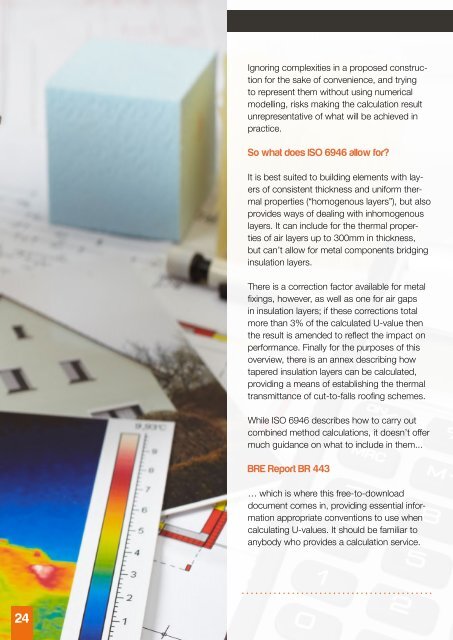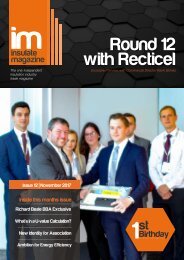Insulate Magazine Issue 11 - October 2017
When is an Insulation Manufacturer not and Insulation Manufacturer headlines the October issue of Insulate Magazine. Possibly the best front cover for an Insulation publication EVER.
When is an Insulation Manufacturer not and Insulation Manufacturer headlines the October issue of Insulate Magazine. Possibly the best front cover for an Insulation publication EVER.
You also want an ePaper? Increase the reach of your titles
YUMPU automatically turns print PDFs into web optimized ePapers that Google loves.
Ignoring complexities in a proposed construction<br />
for the sake of convenience, and trying<br />
to represent them without using numerical<br />
modelling, risks making the calculation result<br />
unrepresentative of what will be achieved in<br />
practice.<br />
So what does ISO 6946 allow for?<br />
It is best suited to building elements with layers<br />
of consistent thickness and uniform thermal<br />
properties (“homogenous layers”), but also<br />
provides ways of dealing with inhomogenous<br />
layers. It can include for the thermal properties<br />
of air layers up to 300mm in thickness,<br />
but can’t allow for metal components bridging<br />
insulation layers.<br />
There is a correction factor available for metal<br />
fixings, however, as well as one for air gaps<br />
in insulation layers; if these corrections total<br />
more than 3% of the calculated U-value then<br />
the result is amended to reflect the impact on<br />
performance. Finally for the purposes of this<br />
overview, there is an annex describing how<br />
tapered insulation layers can be calculated,<br />
providing a means of establishing the thermal<br />
transmittance of cut-to-falls roofing schemes.<br />
While ISO 6946 describes how to carry out<br />
combined method calculations, it doesn’t offer<br />
much guidance on what to include in them...<br />
BRE Report BR 443<br />
… which is where this free-to-download<br />
document comes in, providing essential information<br />
appropriate conventions to use when<br />
calculating U-values. It should be familiar to<br />
anybody who provides a calculation service.<br />
24













